The Brazos Review: AMD's E-350 Supplants ION for mini-ITX
by Anand Lal Shimpi on January 27, 2011 6:08 PM ESTHeavy Lifting: Performance in Complex Workloads
Brazos is clearly faster than Atom in light workloads, but what about in more complex/heavier applications? Are the Bobcat cores enough to allow E-350 systems to move up in the world or will they still be confined to the web browsing/email usage models of netbooks? I've run the E-350 through our entire Bench suite to find out. If you want the full gamut of results head over to CPU Bench, but I've chosen a few here. I also included performance results from a 2.66GHz Pentium 4 to put things in perspective for users of really old systems.
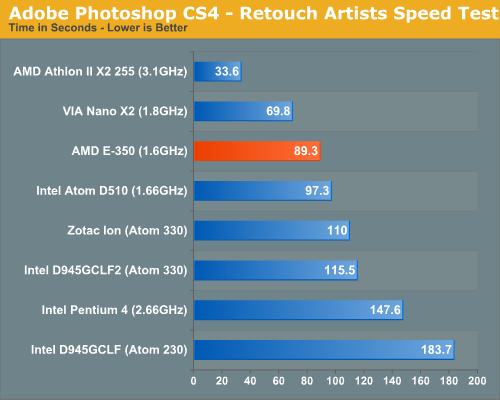
Photoshop CS4 performance is not half bad on the E-350 compared to other similarly priced platforms. Also impressive is the E-350's performance advantage over the old Pentium 4. Compared to the Athlon II X2 however the E-350 is still noticeably slower.
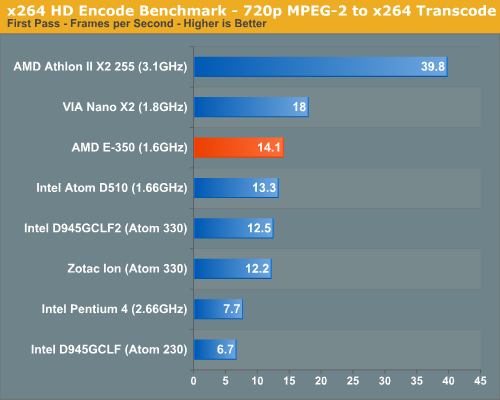
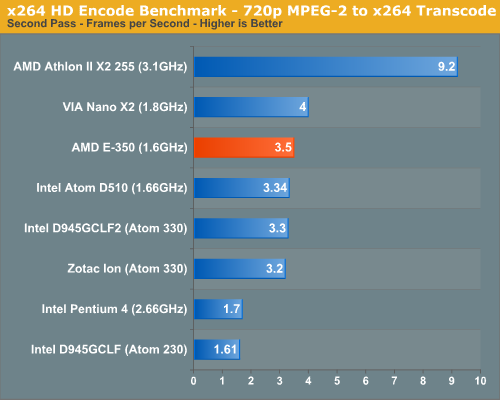
The standings and performance trends continue in our x264 encode benchmark. I don't expect you to do a lot of video transcoding on the E-350 as it's not much faster than Atom here. VIA's dual-core Nano is a bit quicker but still not enough to make this a viable usage case.
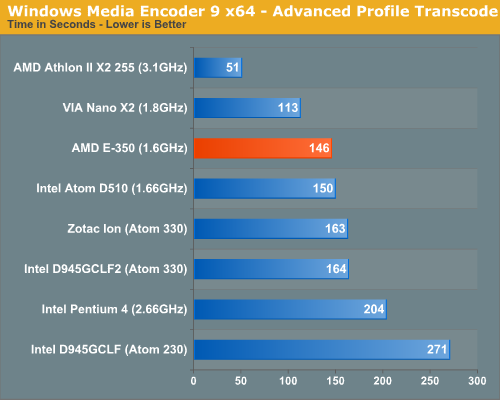
Windows Media Encoder provides a far lighter workload, but the standings don't change. The E-350 is faster than anything Atom based, faster than the old Pentium 4, but slower than VIA's Nano X2.
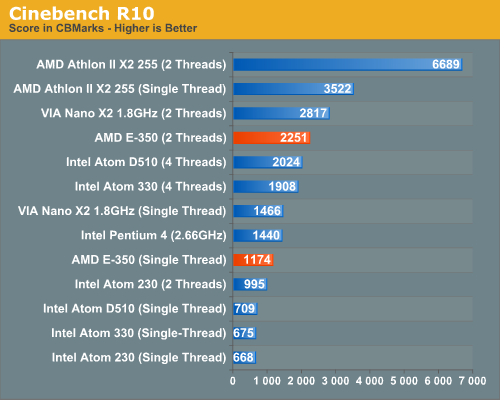
While I don't expect E-350 users to do any offline 3D rendering work, Cinebench does give us a good characterization of single threaded performance. The problem with Atom is that its single threaded performance isn't nearly as good as its multithreaded performance. In all of the previous benchmarks an Atom D510 is clearly quicker than the old 2.66GHz Pentium 4, but looking at single threaded Cinebench R10 you get a different story entirely. The P4 has nearly twice the single threaded performance of an Atom D510.
The E-350 is still a bit behind the Pentium 4 in single threaded performance, but it's not nearly as bad as Atom. The out-of-order execution engine helps tremendously here. What you get as a result is a system that doesn't really feel slower than a 5 year old PC but has the features of a more modern system.
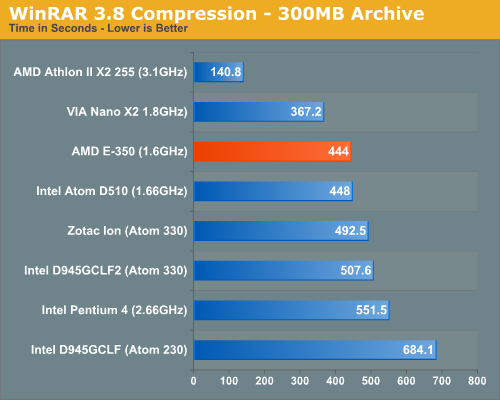
Overall the E-350 is clearly faster than Atom ever was at running these heavier workloads. The highly threaded workloads aren't much faster on E-350 vs. Atom thanks to the latter's Hyper Threading , but single threaded performance continues to play an important role and is a huge advantage of AMD's. VIA's simple out-of-order architecture is consistently faster than the E-350, however I don't expect to see widespread adoption or support for VIA's platform (at least compared to AMD's). Compared to the larger out-of-order x86 cores the E-350 is still in a lower performance class, the Athlon II X2 is easily twice as fast as the E-350 in these tests.
Ultimately the same rules that applied to Atom based systems apply to Brazos systems:
1) Swapping to disk is painful so you need enough memory (I'd recommend no less than 2GB for Windows 7, ideally 4GB) and you'll want a fast HDD. My preference is still an SSD, even a low end value drive over even a fast hard drive. Even a low end SSD (e.g. Kingston SSDNow V100) will make a Brazos system feel acceptably fast.
2) Outside of media playback and some gaming, you're still limited in the types of applications and workloads you can run on Brazos. The Brazos platform is great for web browsing/email workloads, but don't try to do too much more with it. The advantage over Atom here is that Brazos just does those things noticeably faster.










176 Comments
View All Comments
StardogChampion - Friday, January 28, 2011 - link
A low-powered mini-ITX board with 4-5 SATA III ports, maybe a eSATA (Hudson FCH supports 6 x SATA) port and PCI-e slot for adding a SATA controller card (even if it's x4 it's still better than PCI) for $100 has me thinking home server. I don't see a board out there that comes close to these features at this price. If you want a D510 board with 6 x SATA II you have to shell out $200. Take one of these E-350 mini-itx boards, put it in a Lian-Li Q08 case with a bunch of 2TB drives, Amahi/WHS/etc. and you've really got something. It's a waste of GPU but how do you beat it?And, for building friends/family/neighbors desktops to replace the big outdated tower sitting on the floor that they just use for surfing, email, MS Office: once this comes out I'll never build another big tower again.
fr500 - Friday, January 28, 2011 - link
Using mainstream games for this reviews make little sense. It would be better to show it with some good indie games at 720p, say super meat boy (won't run well on an i3 530's IGP or an 9300-ITX IGP for instance it needs good steady FPS to be playable).Maybe Braid, Trine, Torchlight.
I don't see many people using this for MW2.
ProDigit - Friday, January 28, 2011 - link
I would have preferred to see the E-350 compared to an Atom N550,especially with power consumption.I believe the N550 beats the crap out of the E-350 (power-wise). After all, I guess AMD wants to put this apu in netbooks, no?
LeftSide - Friday, January 28, 2011 - link
Does anybody know if bobcat is going to support ecc ram? I want to build a low power server with ecc ram.msroadkill612 - Friday, February 4, 2011 - link
I have read it doesntAmdInside - Friday, January 28, 2011 - link
Will it run Angry Birds?kenyee - Friday, January 28, 2011 - link
Wish you touched more on that...that's listed as a weakness, but nothing about whether anything this year will be able to decode 3D bluray movies...bjacobson - Saturday, January 29, 2011 - link
what are people using OpenCL at this point these days for anyways?spiked_mistborn - Saturday, January 29, 2011 - link
I agree with you geekfool. Where are the OpenCL or DirectCompute benchmarks (especially OpenCL since that is cross-platform and seems to be building steam)? This article does not feel complete without some type of GPU acceleration test since that is one idea that AMD has been pushing since we first started hearing about fusion. The idea was that the low performance of the cpu core on compute intensive workloads could be compensated for by shifting highly parallel workloads to the SPs. If I remember correctly Intel recently released OpenCL support for their CPUs, and there are also upcoming ARM based SOCs that will have OpenCL support.While OpenCL may not matter to everybody today, I think that in a couple of years any devices that are released that don't support it will be skydiving without a parachute.
Klimax - Saturday, January 29, 2011 - link
Just few things:What board with D510 was used and was it with latest BIOS?
I have noticed that after new BIOS is loaded on intel boards I get about ~20% increase in write and ~10% in read performance on SSD. Along with few percent on graphics benches. (Tested between October and January)
Could somebody here test it? (I used BLKD510MO as cheapest D510 board with 1GB DDR2 and Win7 x64 and cheap Kingston SSD)
This is somewhat missing IMHO.
Thanks.